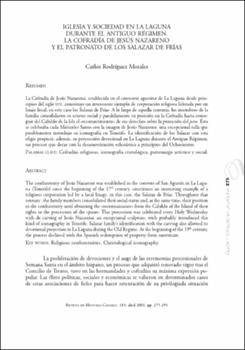Iglesia y sociedad en La Laguna durante el Antiguo Régimen: la cofradía de Jesús Nazareno y el patronato de los Salazar de Frías
Author
Rodríguez Morales, CarlosDate
2001Abstract
La Cofradía de Jesús Nazareno, establecida en el convento agustino de La Laguna desde principios
del siglo XVII, constituye un interesante ejemplo de corporación religiosa liderada por un
linaje local, en este caso los Salazar de Frías. A lo largo de aquella centuria, los miembros de la
familia consolidaron su estatus social y paralelamente su posición en la Cofradía hasta conseguir
del Cabildo de la Isla el «reconocimiento» de sus derechos sobre la procesión del paso. Ésta
se celebraba cada Miércoles Santo con la imagen de Jesús Nazareno, una excepcional talla que
posiblemente introdujo su iconografía en Tenerife. La identificación de los Salazar con esta
efigie propició, además, su proyección devocional en La Laguna durante el Antiguo Régimen,
un proceso que decae con la desamortización eclesiástica a principios del Ochocientos. The confraternity of Jesús Nazareno was established in the convent of San Agustín in La Laguna
(Tenerife) since the beginning of the 17th century, constitutes an interesting example of a
religious corporation led by a local linage, in this case, the Salazar de Frías. Throughout that
century , the family members consolidated their social status and, at the same time, their position
in the confraternity until obtaining the «reconnaissance» from the Cabildo of the Island of their
rights to the procession of the «paso». This procession was celebrated every Holy Wednesday
with de carving of Jesús Nazareno, an excepcional sculpture, wich probably introduced this
kind of iconography in Tenerife. Salazar family’s identification with the carving also allowed its
devotional projection in La Laguna during the Old Regime. At the beginning of the 19th century,
the process declined with the Spanish redemption of property from mortmain.





